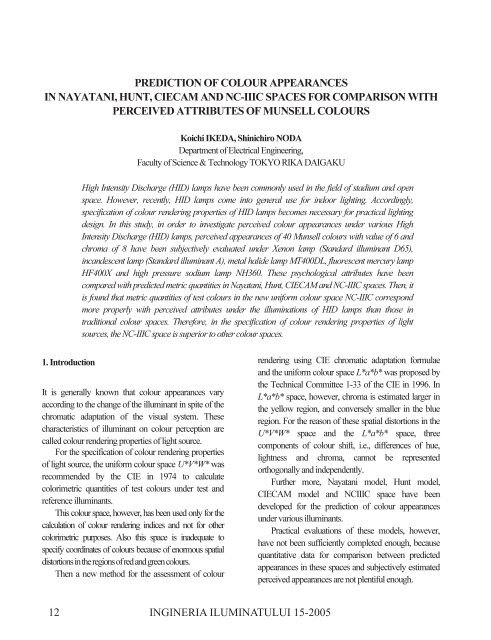Ingineria Iluminatului - Journal of Lighting Engineering - Prof. Florin ...
Ingineria Iluminatului - Journal of Lighting Engineering - Prof. Florin ...
Ingineria Iluminatului - Journal of Lighting Engineering - Prof. Florin ...
Create successful ePaper yourself
Turn your PDF publications into a flip-book with our unique Google optimized e-Paper software.
PREDICTION OF COLOUR APPEARANCES<br />
IN NAYATANI, HUNT, CIECAM AND NC-IIIC SPACES FOR COMPARISON WITH<br />
PERCEIVED ATTRIBUTES OF MUNSELL COLOURS<br />
1. Introduction<br />
12<br />
Koichi IKEDA, Shinichiro NODA<br />
Department <strong>of</strong> Electrical <strong>Engineering</strong>,<br />
Faculty <strong>of</strong> Science & Technology TOKYO RIKA DAIGAKU<br />
High Intensity Discharge (HID) lamps have been commonly used in the field <strong>of</strong> stadium and open<br />
space. However, recently, HID lamps come into general use for indoor lighting. Accordingly,<br />
specification <strong>of</strong> colour rendering properties <strong>of</strong> HID lamps becomes necessary for practical lighting<br />
design. In this study, in order to investigate perceived colour appearances under various High<br />
Intensity Discharge (HID) lamps, perceived appearances <strong>of</strong> 40 Munsell colours with value <strong>of</strong> 6 and<br />
chroma <strong>of</strong> 8 have been subjectively evaluated under Xenon lamp (Standard illuminant D65),<br />
incandescent lamp (Standard illuminant A), metal halide lamp MT400DL, fluorescent mercury lamp<br />
HF400X and high pressure sodium lamp NH360. These psychological attributes have been<br />
compared with predicted metric quantities in Nayatani, Hunt, CIECAM and NC-IIIC spaces. Then, it<br />
is found that metric quantities <strong>of</strong> test colours in the new uniform colour space NC-IIIC correspond<br />
more properly with perceived attributes under the illuminations <strong>of</strong> HID lamps than those in<br />
traditional colour spaces. Therefore, in the specification <strong>of</strong> colour rendering properties <strong>of</strong> light<br />
sources, the NC-IIIC space is superior to other colour spaces.<br />
It is generally known that colour appearances vary<br />
according to the change <strong>of</strong> the illuminant in spite <strong>of</strong> the<br />
chromatic adaptation <strong>of</strong> the visual system. These<br />
characteristics <strong>of</strong> illuminant on colour perception are<br />
called colour rendering properties <strong>of</strong> light source.<br />
For the specification <strong>of</strong> colour rendering properties<br />
<strong>of</strong> light source, the uniform colour space U*V*W* was<br />
recommended by the CIE in 1974 to calculate<br />
colorimetric quantities <strong>of</strong> test colours under test and<br />
reference illuminants.<br />
This colour space, however, has been used only for the<br />
calculation <strong>of</strong> colour rendering indices and not for other<br />
colorimetric purposes. Also this space is inadequate to<br />
specify coordinates <strong>of</strong> colours because <strong>of</strong> enormous spatial<br />
distortions in the regions <strong>of</strong> red and green colours.<br />
Then a new method for the assessment <strong>of</strong> colour<br />
INGINERIA ILUMINATULUI 15-2005<br />
rendering using CIE chromatic adaptation formulae<br />
and the uniform colour space L*a*b* was proposed by<br />
the Technical Committee 1-33 <strong>of</strong> the CIE in 1996. In<br />
L*a*b* space, however, chroma is estimated larger in<br />
the yellow region, and conversely smaller in the blue<br />
region. For the reason <strong>of</strong> these spatial distortions in the<br />
U*V*W* space and the L*a*b* space, three<br />
components <strong>of</strong> colour shift, i.e., differences <strong>of</strong> hue,<br />
lightness and chroma, cannot be represented<br />
orthogonally and independently.<br />
Further more, Nayatani model, Hunt model,<br />
CIECAM model and NCIIIC space have been<br />
developed for the prediction <strong>of</strong> colour appearances<br />
under various illuminants.<br />
Practical evaluations <strong>of</strong> these models, however,<br />
have not been sufficiently completed enough, because<br />
quantitative data for comparison between predicted<br />
appearances in these spaces and subjectively estimated<br />
perceived appearances are not plentiful enough.
















